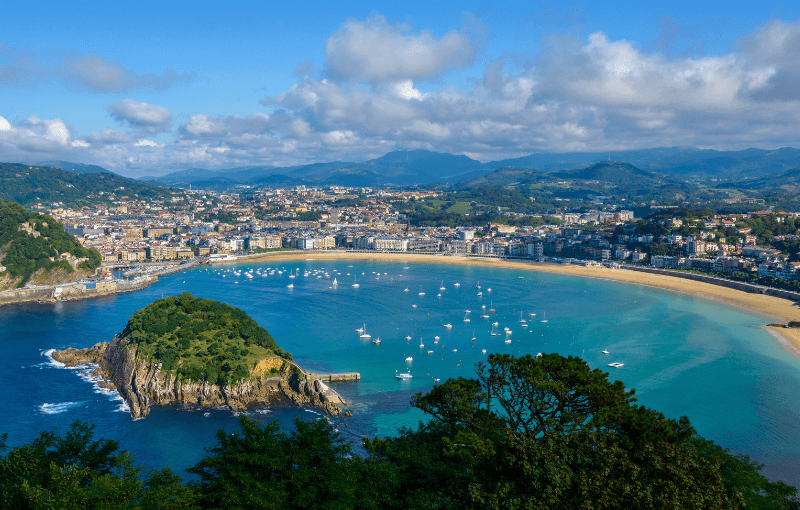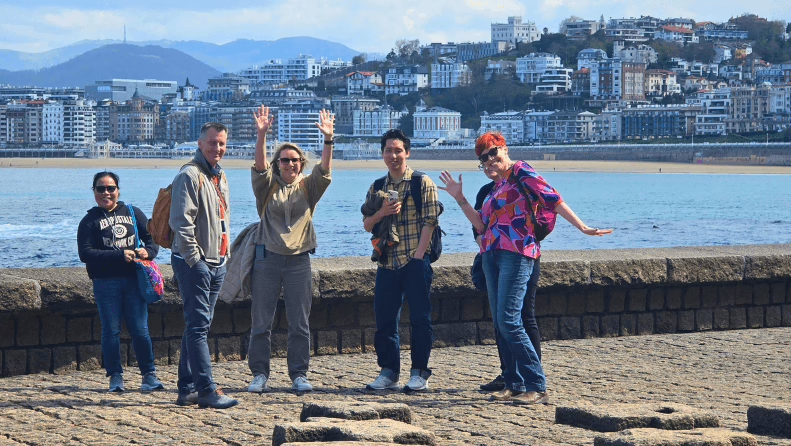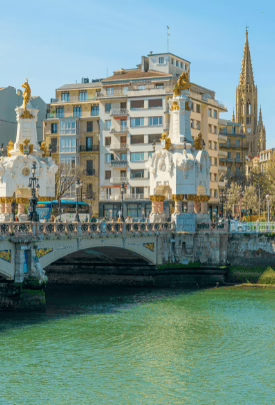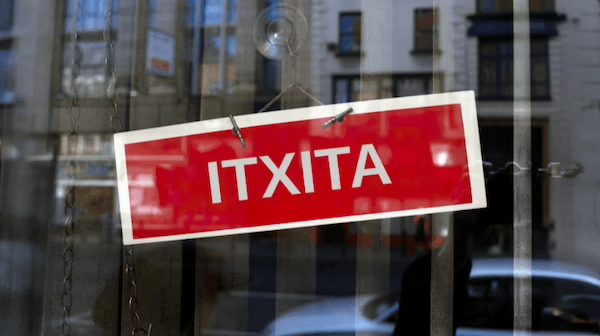From Hola to Kaixo: My San Sebastián Language Story – and maybe yours!
So I made it to San Sebastián, much thanks to the recommendations of ILI and I’m living here for 7 weeks in total, with 5 of those weeks in international Spanish classes up here in Northern Spain.

With the very best language learning journeys, there’s always a twist. And mine is that I’ve come to one of the areas of Spain where Spanish is not the only dominant language.
Here, the Spanish language co-exists alongside a much older counterpart, Euskara, the unique and ancient Basque language.
For language learners, San Sebastián offers the rare opportunity to experience a deeply immersive environment – not only in Spanish, but in a vibrant, bilingual culture. Whether you’re savoring tapas (called pintxos here) in the Parte Vieja (Old Town), chatting with shopkeepers in Mercado de la Bretxa, or watching a Basque dance performance on the waterfront, every interaction becomes a chance to grow your language skills and cultural understanding.
But the big question on your mind may well be – does it work? Is the idea to study Spanish in San Sebastián a good one, with two languages intermingling like they do here? I’m going to get to that, but first, let me introduce you to my amazing home from home.
San Sebastian: More Than a Tourist Destination
The Allure of Donostia
Known to locals as Donostia – its name in Euskara – San Sebastian is a city where supreme elegance meets authenticity. Nestled along Spain’s northern coast, its golden beaches and Belle Époque architecture have long attracted international visitors. But beyond the postcard-perfect views, it’s the lively street culture, innovative gastronomy, and deep-rooted local traditions that make San Sebastian feel utterly real and accessible.
The secret to not feeling like a fish out of water, or a token tourist is simple, and singular. Speak the language.
Why San Sebastian is Ideal for Language Learning
In my first week in ILI’s recommended Spanish language school, I meet Markus from Germany. He is an almost total beginner, but he tells me with his lovely dry humour how, on his second night in the town, he spent 2 hours in a bar being spoken to in Spanish by friendly locals. He didn’t understand very much, but he thoroughly enjoyed himself!
The city is very walkable, the vibe on the street is extremely friendly, and, as Markus found out, it’s full of opportunities for spontaneous conversation – whether you’re ordering a coffee in Spanish or asking for directions on your way to class. The pace here is relaxed, the staff in the bars and cafes don’t seem to mind at all where you’re from, but use some local language, Spanish or Basque, and it’s like turning a key to unlock a whole other level of friendliness and warmth.
Euskara: The Basque Language
You’ll see signs in two languages everywhere – and that’s part of the charm. Euskara is one of Europe’s oldest languages, unrelated to Spanish or any other major language. It’s deeply tied to Basque identity and culture.
On our first day, the lovely Julia takes us on a very informal tour of the centre of town, culminating in the stunning Parte Vieja, though I have to say that all of San Sebastián is beautiful to look at.
She explains to us the key to fitting in, is to start by just learning the words in Euskara for hello, goodbye, please, thank you and sorry (for when you inevitably bump into someone later on in the evening!). More of that in a minute.







The Spanish Learning Experience
The School
The school is excellent, and manages to reflect perfectly my experience of San Sebastián as a whole, in that everyone is super friendly, but in an authentic way. The conversations are real, earthy and not laminated in a plasticky, shiny layer of customer service which can be the case with bigger schools and mass tourism. I am so proud that ILI has partnered with the school, because you can feel similar values shining through, however rusty my A2/B1 Spanish!
I’m here in low season, from April to June, and the school is just the right level of busy. I’m assured the group sizes are never massive, but I particularly relish being in a class of 4 – 6 people of a very similar level of Spanish to me.
Immersion Beyond the Classroom
San Sebastián makes it easy to take what you learn in class and apply it instantly, or, if you’re not quite ready for that, at least to listen out for the kinds of phrases you’ve just been covering in lessons.

You’ll practice Spanish while ordering Pintxos (don’t say ‘tapas’ here!), asking for a beer or glass of wine, booking surf lessons, or browsing the hundreds of high-end (but again, super-friendly) shops and the occasional thrift store, full of very decent clothes.
But most of all, it’s the Pintxos. It’s all about the Pintxos. No seriously. Because, in the words of Regina Spektor, this is the way you ‘brush up against strangers’. It’s what the locals do, especially on the nights of the week (Tuesdays and Thursdays) where bars in certain areas of town offer Pintxo Pote – a snack and drink for the bargain price of a couple of euros. This gets underway from about 7pm, and the school will give you a list of where to go for which speciality.
The Importance of Local Interactions
Locals here are proud of their home and usually happy to engage. Don’t be afraid to start small conversations – at the bakery, on the bus, or during a community event.
These moments are not only a great way to anchor the phrases you’ve learned into a happy place in your vocabulary memory bank, but also totally help you feel like you belong. And that’s one of the most powerful motivators for language learning, surely.
Navigating the Dual-Language Reality
Understanding the Basque Context
The Basque Country isn’t just a region – it’s a cultural heartbeat. Euskara is a symbol of identity, resilience, and pride. You’ll notice that children often attend bilingual schools, and official announcements are made in both languages. While it may feel complex at first, it’s a beautiful example of how languages can coexist – and how learning Spanish in San Sebastian gives you access to a deeper cultural story.
I’m finding I’m still very much here to learn Spanish. I’m not derailed in any way by Basque being here. It just makes it all a bit more interesting, more rich.
Tips for Respectful Cultural Interaction
Our teacher-guide Julia finishes our town tour by taking us to the Tourist Information office, where we all pick up free Basque phrase books.
Here’s what she recommends you learn:
- Kaixo (kai-sho) – hello!
- Mesedez (mess-a-dez) – please!
- Eskerik Asko – literally say it how it sounds. That’s thank you (and my favorite)
- Agur (agoor) – bye!
- Barkatu (bark-a-too) – sorry!
In the grand scheme of things, that’s not too much to commit to memory. Watch eyes warm and smiles appear as you use it. You can see people’s gratitude. Then, of course, hit them with whatever Spanish your level allows – it’s not rude to make the switch when you run out of words. The important bit was showing your respect. You had them at the first Kaixo!
The Benefits of Dual-Language Exposure
Being in a bilingual environment arguably enhances your brain’s ability to switch between languages – like a cognitive boost. It’s certain that after you’ve wrapped your head around the Euskara phrase book for 10 minutes, Spanish does feel like a walk in the park!
What Makes San Sebastian an Unforgettable Language Experience?
San Sebastián isn’t just a place to learn Spanish – it’s a place to live it.
I’m not here learning Spanish to build my level and go use it somewhere else. San Sebastián – Donostia – doesn’t feel interchangeable. It couldn’t be a carbon copy of just about any other seaside town in Spain. And that feels spine-tingling and exciting and special.
Another shout-out to the ILI team through whom I booked this programme. You applied your own values and steered me to a school in the same family, which is true to your values and mine. I am ecstatic to be here, learning Spanish and just a little Euskara on the side.
Related Articles
- Best Way to Learn a Language: At Home or Through Immersion Abroad?
- Beyond the screen: Applying your online Spanish in the real world
- Maximize your dollar: Budget tips for Spanish language students in Colombia
- Beginner to Intermediate Spanish: 4 Simple Steps to Achieve it
- Explore all the Spanish speaking destinations ILI partners with abroad
- Build a foundation by taking a Spanish class at ILI first before going abroad.
